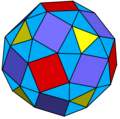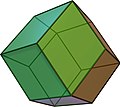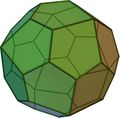| Snub rhombicuboctahedron | |
|---|---|
 | |
| Schläfli symbol | srr{4,3} = |
| Conway notation | saC |
| Faces | 74: 8+48 {3} 6+12 {4} |
| Edges | 120 |
| Vertices | 48 |
| Symmetry group | O, [4,3]+, (432) order 24 |
| Dual polyhedron | Pentagonal tetracontoctahedron |
| Properties | convex, chiral |
The snub rhombicuboctahedron is a polyhedron, constructed as a truncated rhombicuboctahedron. It has 74 faces: 18 squares, and 56 triangles. It can also be called the Conway snub cuboctahedron in but will be confused with the Coxeter snub cuboctahedron, the snub cube. See snub cuboctahedron.










